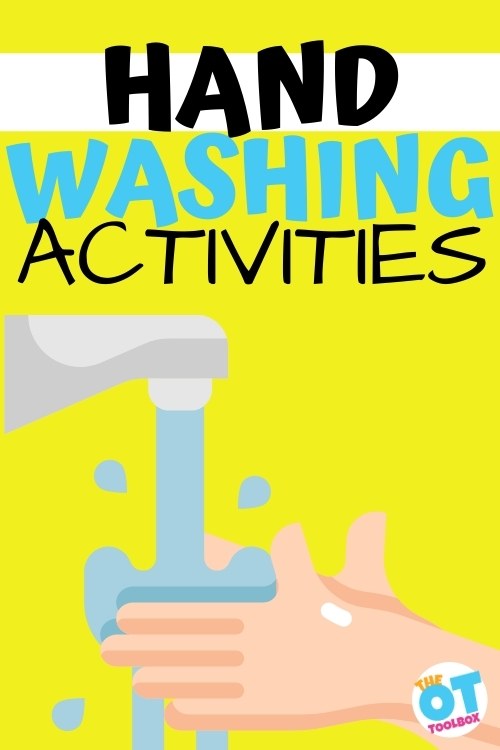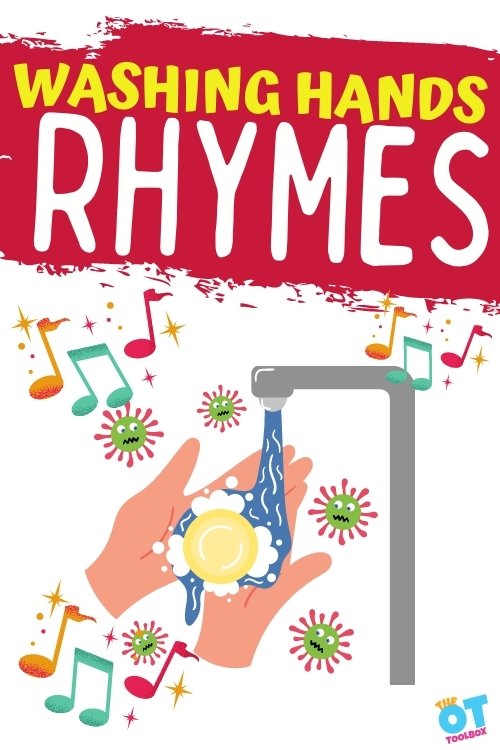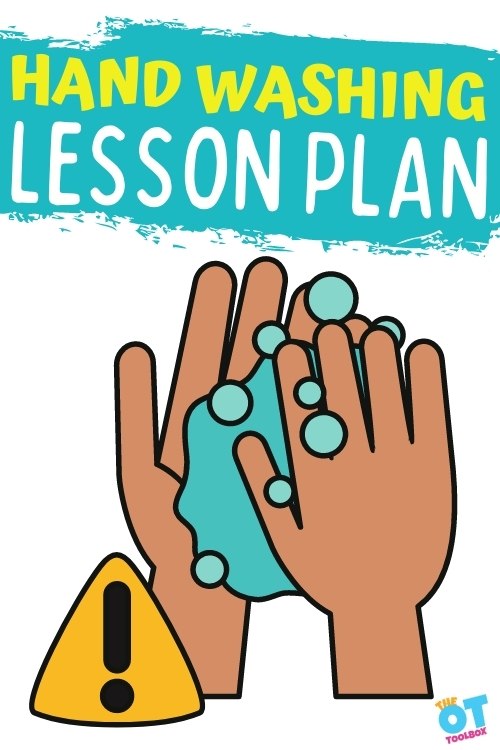Today, we’re talking handwashing activities. These self-hygiene activities can be used as a hand washing activity for preschoolers, when teaching kindergarteners to wash their hands, and even older kids that struggle with completely washing their hands. Add these multisensory ideas to add to a hand washing lesson plan.

We all know that handwashing is so important. Per the Centers for Disease Control, it is the most effective method to prevent the spreading of germs. Of course, we all want children to be healthy for participation in school, daycare, and other daily life events so that their growth continues undisturbed. We want them remaining healthy to enjoy their days of play and learning while essentially building their bodies and brains!
We also know that handwashing is the last thing that a child feels like they need to do. Younger children do not understand what purpose it serves as they do not see a direct impact on themselves (unless they can see the dirt literally wash off their hands and down the drain). Older kiddos think that a simple handwashing is all it takes as they went through all of the steps and think, “That’s good” when really their routine didn’t wash away all those icky germs and some are still on the hands ready to move onto others. Yuck!!
how to wash hands for kids
In this post, we will look at handwashing tips, tricks, and activities that can help children of all ages, and even some adults, manage their handwashing hygiene and help to keep themselves and others healthy and well. Essentially, getting the true ‘ick’ off of the hands and down the drain where they belong!
Handwashing Tips and Tricks:
- Allow the child to pick their own hand soap scent and give them the opportunity to decorate the container with their own touch of stickers, glitter, marker drawings, etc. Some children enjoy placing small plastic toys inside the dispenser as well. Take a look at these fun Lego and Halloween soap ideas.
- Give the child a variety of options to choose from when picking a hand soap, such as bar vs. pump, foam vs. gel, etc. Maybe a bar of soap in a mesh baggie would help.
- Allow the child to choose their favorite hand drying towel or buy a special towel just for this purpose. Maybe it’s a fun themed towel or simply a fluffy towel that feels good to the hands. Think positive experience, so no scratchy towel fabric here.
- Incorporate a fun handwashing song into their handwashing routine. There are so many fun songs out there with some being designed to help the child wash better and longer to cleanse those germs away. Take a look at these fun Handwashing Songs! Songs can be super helpful for younger kiddos.
- Bring a few of their favorite toys to the handwashing routine to encourage their engagement. They can play with them after they wash their hands thoroughly.
- Consider using a visual timer to help them wash their hands for the appropriate length of time to cleanse those germs away. This is helpful for older kiddos. Think about a visual gel timer that lasts 20-30ish seconds.
- Make sure the sink is comfortably accessible to the child. Can they reach the faucet? Can they place hands directly under the faucet and above the basin comfortably? Consider using foot stools, faucet handle extenders or grippers, and faucet extenders. You can purchase these in fun themes or if you are creative, make your own! Take a look at this DIY faucet extender and fun faucet set. If you prefer to have something more adult-like in theme, take a look at this simple faucet extender.
- Sometimes if a child is able to see themselves in the mirror behind the sink, they are ready to wash their hands while watching themselves. You’ll see them make funny faces, showing different facial expressions, etc. Make sure the child is able to multi-task to do this.
- Consider adding a few fun window clings to the mirror that can watch the child as they work on handwashing hygiene. Let the child pick them out, maybe you can change them with every holiday.
- Consider joining the child for the handwashing routine. This shows that that everyone must take the time to wash their hands throughout the day.
- Create a sticker reward chart as an incentive to have the child work on handwashing skills. Maybe a reward that they would really want could be the handwashing motivator.
- Use these free Hand Washing Posters and step by step visual schedule by Your Therapy Source to assist with teaching children proper handwashing techniques. The fun posters have a visual reminder and when it’s important to perform handwashing. Also, they have a fun Hand Washing Activities Packet that has a variety of hand hygiene activities.
- Consider the water temperature as some children do not like certain water temperatures. Help them set the water temperature they like to motivate them to complete thorough handwashing.
- If the child does not yet know how to set the water temperature, help them learn to do so. Use visual supports for water temp clarification by wrapping each handle with tape that is the color for hot (red) and the color for cold (blue). If you have one central handle, place arrows on the sink backsplash surface with these same colors and the words ‘hot’ and ‘cold’ written on the arrows. You can also purchase some colored indicators from a hardware store, if that is your preference.
Using fun activities can help children to learn the importance of appropriate handwashing hygiene. The activities not only serve the purpose of being fun, but they serve a more important purpose of demonstrating the need and the value of proper handwashing. Sometimes teaching kids to wash their hands properly requires some creativity and FUN!
Handwashing Activities
Below are some handwashing activities that help engage children in the hand hygiene process while also providing valuable learning experiences to clarify why this foundational skill is necessary in their daily lives.
- This sensory ‘bin’ activity involves the use of a water bin and latex gloves – Wash Your Hands – a playful exploration using latex gloves, ice, and water making it the perfectly blended sensory, science, and health activity.
- This Clean Hands sensory ‘bag’ activity involves the use of hands drawn on a gel-filled, pom-pom baggie and the use of bottle brush. It helps children to learn to get the hands squeaky clean by scrubbing away those pom-pom germs.
- This fun self-care activity – Germy Hand – is an OT activity that adds a fine motor and functional component to learning the importance of proper handwashing as the child learns a handwashing song and works on germ buttoning to dirty the hand and then follows with germ unbuttoning to cleanse the hand.
- Read a germ book or two to help children learn about why handwashing is important. Review this 20 Germ Books for Kids post by Fun with Mama to see all of the options you could use with a variety of children.
- Ice Cube Handwash is an OT activity that promotes tactile tolerance through extended engagement with water and ice in order to encourage a child to work on thoroughness and find enjoyment in hand hygiene.
- Use this Glitter Germs Activity to help children understand visually what exactly they working on washing away with proper handwashing. It involves the use of lotion and glitter and creates a fun germ-spreading game!
- Use this fun OT Fuzzy Germ Craft activity to teach about germs. You can easily add it to your reading of a germ-themed book and you’ll have a whole lesson plan for germs! This is a great activity for older kids!
- This bread science experiment is a disgustingly real way to teach about the importance of proper handwashing and why hand hygiene is so important. This will really convince children to wash their hands and will probably help them do it without you even reminding them!
- This pepper science experiment is a unique way to teach younger children about why it’s so important to wash their hand and use soap to do so.
- Use this free Handwashing Social Story to work with individual children or even a small group of children. It is highly detailed and uses full color photos instead of more abstract clipart. Check out our tips for how to write a social story to get started.
- Use the free step by step visual schedule printable from Your Therapy Source and cut apart the individual steps to hide around the room and have the child do a handwashing scavenger hunt. Once they find all of the steps, they place them into the correct sequence. This is a great OT activity!
- This Icky Germs Craft makes for another fun activity that incorporates hand tracing, coloring, and cutting skills. It also allows for some creativity with germ creations.
- This germy hand craft is similar to the one above, but it adds a fun little paper soap element that helps children relate to the need to use soap to cleanse away those icky germs!

Washing Hands Rhymes
Individuals that learn best through multisensory input may appreciate a hand washing rhyme. When kids are exposed to the rhythm and rhyme of a saying that teaches handwashing, the individual steps may be more likely to stick.
These washing hands rhymes ideas are great to use in teaching handwashing to preschoolers, kindergarteners…and older kids!
Each of these rhyme ideas have several goals: to get kids to learn to wash their hands, to use each step of handwashing, and to scrub with soap for a longer period of time.
- Handwashing rhymes from My 1st Years
- Wash Your Hands Nursery Rhymes Video (YouTube)
This is the way we Wash Our Hands Washing Hands Rhyme
(Sung to the tune of All Around the Mulberry Bush)
This washing hands rhyme teaches kids about the hygiene concept of washing hands before eating.
This is the way we wash our hands
Wash our hands
Wash our hands
This is the way we wash our hands
Before we eat our food.
Tops and Bottoms Hand Washing Rhyme
(Sung to the tune of Frere Jacques)
This hand washing rhyme teaches kids each step of the hand washing process, including where to scrub with soap.
Tops and Bottoms, Tops and Bottoms, (Rub top and bottom of hands)
In between, In between, (Rub fingers inside on both hands)
All around our hands, All around our hands, (Wash all over)
Then we rinse. Then we dry.

hand washing lesson plan
If you are teaching handwashing, using a hand washing lesson plan is one way to stay on track with teaching the correct concepts of hand hygiene, and making sure the steps of handwashing sticks with kids. Those with cognitive deficits, attention challenges, executive functioning needs, and others may struggle with each step. This is where a handwashing lesson plan comes into play.
Pick and choose the handwashing activities listed above to incorporate into a lesson plan. This could be included in an overall life skills class, a self-hygiene course, or even daily functional task lessons.
A specific handwashing lesson plan may include:
Handwashing Lesson Plan
- Title of Lesson: Handwashing
- Time: 1 day-1 week
- Subject Areas: Self-Help Skills; Life Skills
- Media: Books, Play activities, Online videos, manipulatives, handwashing station or sink, soap, water, towel, isolated sink in classroom, public bathroom
- Objective: Student will learn to wash their hands.
- Procedures for Lesson:
- Read a handwashing book or germ book (see above)
- Complete a germ experiment or multisensory activity related to germs (see above)
- Write the list of steps for handwashing. Student can copy onto paper.
- Discuss each step of handwashing.
- Sing washing hands rhymes (see above)
- Complete a how-to writing task. Student can write independently the steps of handwriting.
- Manipulate needed materials: soap, water, towel, paper towel, sink, water handles, water temperature, air dryer.
- Interactive activity with peers: Sort handwashing visual cards into steps.
- Key Vocabulary:
- Germs
- Water
- Temperature
- Soap (types: liquid soap, bar soap, antibacterial, soap dispenser, etc.)
- Dry/wet
- Towel, paper towel, napkin, air dryer
- Scrub
- Rinse
- Practice and Application:
- Student describes steps of handwashing.
- Practice handwashing at a sink using dry materials on the hand such as a light dusting of flour or cornmeal.
- Practice handwashing at a sink, using all of the steps.
- Handwashing in public space such as school bathroom where there may be other bathroom users, loud noises, and distractions.
- Scaffolding:
- Modeling
- Guided practice
- Independent practice
- Grouping Options:
- Individual
- Small groups
- Large groups
- Peer activity
- Partners
In this post are ample tips and tricks to try with kiddos to help them learn the importance of this foundational skill and build the motivation to do so. There are links to engaging activities to help a child learn when and why to do proper handwashing.
However, if you should have other concerns about your child that these tips or tricks do not address, please contact an occupational therapy provider to discuss. Your child may have other underlying issues, such as sensory processing, motor planning, bilateral coordination, strength, and executive functioning needs.

Regina Parsons-Allen is a school-based certified occupational therapy assistant. She has a pediatrics practice area of emphasis from the NBCOT. She graduated from the OTA program at Caldwell Community College and Technical Institute in Hudson, North Carolina with an A.A.S degree in occupational therapy assistant. She has been practicing occupational therapy in the same school district for 20 years. She loves her children, husband, OT, working with children and teaching Sunday school. She is passionate about engaging, empowering, and enabling children to reach their maximum potential in ALL of their occupations as well assuring them that God loves them!






